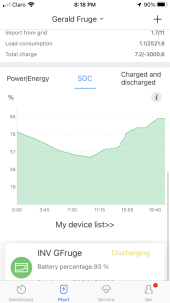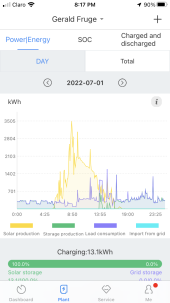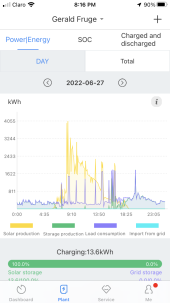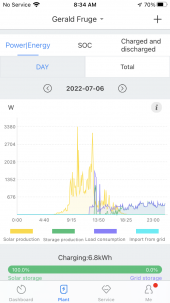You are using an out of date browser. It may not display this or other websites correctly.
You should upgrade or use an alternative browser.
You should upgrade or use an alternative browser.
Adding more panels to charge batteries clarification
- Thread starter GFruge
- Start date
Should do just fine in what way?So, an 80A 48Vcharge controller with 5,000 watts capacity should do just fine?
It's actually odd that it claims to support 5kW of solar when it's only an 80A 48V controller. If your battery is charging at 54.4V and 80A then it can only make use of 4352W of solar. You can certainly put 5kW of panels but no more than about 4.4kW will ever be used. You already have 5300W. Adding 1060W more would only be useful at times when there is less sun such as winter or cloudy days or even earlier and later in the day. The extra panels will allow you to get more power in those conditions but it will be mostly worthless in the spring and summer.
400bird
Solar Wizard
What's the max charge you are seeing from the current set up? If you're getting 4,000 watts max, then maybe you'd get real benefit from adding another 1,000 watts of panels.
Otherwise, adding a 5kw charge controller is overkill for 1,000 watts of panels. You could get an appropriately sized charge controller and save some money (unless you think you'll need to add more panels again in the future)
Otherwise, adding a 5kw charge controller is overkill for 1,000 watts of panels. You could get an appropriately sized charge controller and save some money (unless you think you'll need to add more panels again in the future)
The max that I’ve seen on a very quick spike has been 4,000 watts. The max on a constant charge has been around 2,600 watts on completely sunny days. Where it usually charges is around 1,500 - 1,800 watts.
So, I’m confused again.
My current inverter/charge controller has a limitation of 5,000 watts. I’m exceeding that now, but it’s possible to add more panels because of my charge rate. I understand all of that.
So, going back to my original topic. Is it possible to add another charge controller, say an 80A 48v? Put say 4,000 watts worth of panels and charge the batteries and have that extra capacity available to absorb more UV for the cloudy/rainy days?
Or does everything have to be routed through my inverter/charge controller and be limited to whatever I can overpanel to reach my max input?
So, I’m confused again.
My current inverter/charge controller has a limitation of 5,000 watts. I’m exceeding that now, but it’s possible to add more panels because of my charge rate. I understand all of that.
So, going back to my original topic. Is it possible to add another charge controller, say an 80A 48v? Put say 4,000 watts worth of panels and charge the batteries and have that extra capacity available to absorb more UV for the cloudy/rainy days?
Or does everything have to be routed through my inverter/charge controller and be limited to whatever I can overpanel to reach my max input?
Adding another 80A charge controller would be fine if your battery bank handle up to 160A of charge current.
But first I would figure out why you are getting such poor performance from your existing setup.
But first I would figure out why you are getting such poor performance from your existing setup.
Ampster
Renewable Energy Hobbyist
You can have two charge controllers. Just be sure if they are both going at full amperage that the current does not exceed the recommended current for your battery pack
400bird
Solar Wizard
To add to what rmaddy and Ampster said.
You could have 35 independent charge controllers as long as charge current stays within the battery's charge current limit.
Sorry I distracted the thread, I didn't realize the question was so direct.
You could have 35 independent charge controllers as long as charge current stays within the battery's charge current limit.
Sorry I distracted the thread, I didn't realize the question was so direct.
According to the operating manual, the 6kw unit that I have has a max charge of 60A. I entered the system on the inverter, it’s currently set at a max charge rate of 140A which is the highest it’ll go. The batteries show 100A max charge rate.
So, since the inverter will only give 60A, I can add 40A to max out.
I'm quite certain that even though I will have 3 batteries, the same remains at 100A.
So, since the inverter will only give 60A, I can add 40A to max out.
I'm quite certain that even though I will have 3 batteries, the same remains at 100A.
If connected to 240VAC input, the charger can charge at up to 60A. This is separate from the up to 80A of charge current from solar.
If your batteries state 100A of max charge current then that is per battery. If you put 3 in parallel then your battery bank will support 300A of charge current.
So you can simultaneously charge at 80A from the solar, 60A from utility/generator, and another 80A (or whatever) with a second charge controller. That's up to 220A of charge leaving room for a 3rd 80A charge controller.
If your batteries state 100A of max charge current then that is per battery. If you put 3 in parallel then your battery bank will support 300A of charge current.
So you can simultaneously charge at 80A from the solar, 60A from utility/generator, and another 80A (or whatever) with a second charge controller. That's up to 220A of charge leaving room for a 3rd 80A charge controller.
Thanks for the clarification. Now I’m clear with a direction of adding another charge controller and more panels.
As far as current performance, I just assumed that I was doing good with the charge that I was getting. From what I think you see, it’s not doing well. I don’t know if my location or altitude has anything to do with it. I live in the mountains at 3,200’ above sea level. My panels are faced east, so I get morning charge.
If there’s anything you think that may be wrong, give me some direction and I’ll check it out.
As far as current performance, I just assumed that I was doing good with the charge that I was getting. From what I think you see, it’s not doing well. I don’t know if my location or altitude has anything to do with it. I live in the mountains at 3,200’ above sea level. My panels are faced east, so I get morning charge.
If there’s anything you think that may be wrong, give me some direction and I’ll check it out.
Getting only 2600W out of 5300W of panels seems low, especially if you are in the northern hemisphere where the sun is about as high in the sky as it gets right now. That's only 49%. Being at 3,200' is fine. I'm currently at 4,100' and I got 76% out my flat mounted panels for a bit today. I've camped as high as 12,000' with my trailer and had no issue with the solar.
East facing panels is likely a big issue. You will only get morning sun and may never get as much as south facing panels would allow.
What is your latitude?
What angle are your panels relative to the horizon?
What direction exactly do they face? 90º is due east.
Do you have any shading?
What is the temperature at about 10am? If it's 100ºF then you'll lose a lot of power from the hot panels. If it's 40ºF then you should be getting extra power.
Do you have a graph showing your PV input over the course of a typical day?
When your panels do max out at 2600W what is the SOC of your battery bank? Do you have any loads on your system at the time? If you put an 80A (or higher) load on your system do you get better output from your panels?
East facing panels is likely a big issue. You will only get morning sun and may never get as much as south facing panels would allow.
What is your latitude?
What angle are your panels relative to the horizon?
What direction exactly do they face? 90º is due east.
Do you have any shading?
What is the temperature at about 10am? If it's 100ºF then you'll lose a lot of power from the hot panels. If it's 40ºF then you should be getting extra power.
Do you have a graph showing your PV input over the course of a typical day?
When your panels do max out at 2600W what is the SOC of your battery bank? Do you have any loads on your system at the time? If you put an 80A (or higher) load on your system do you get better output from your panels?
I’ll try to answer the best I can.
Panels are actually facing 135* (Southeast)
No shading at the house
I start getting a charge around 6am. It ramps up pretty quick.
Inclination of the panels are approx 20-25%.
Temperature around sunrise is 60ish degrees F. Only warms up to 75 degrees all day.
On a normal day, the highest amp draw I have is a well pump and pressure pump and rarely run at the same time. Both draw about 12 amps. House is complete with LED lights. No air conditioning. Just fans and open windows.
Panels are actually facing 135* (Southeast)
No shading at the house
I start getting a charge around 6am. It ramps up pretty quick.
Inclination of the panels are approx 20-25%.
Temperature around sunrise is 60ish degrees F. Only warms up to 75 degrees all day.
On a normal day, the highest amp draw I have is a well pump and pressure pump and rarely run at the same time. Both draw about 12 amps. House is complete with LED lights. No air conditioning. Just fans and open windows.
Attachments
Your solar production is only going to be as high as your needs. If your batteries are nearly full and your loads are low then you have little need for a lot of solar so your production will match. Run your batteries down to 75% SOC and put as many loads on as you can in the morning and see how your production goes.
I'm not sure why you are considering adding more solar when it seems you don't need as much as you already have.
I'm not sure why you are considering adding more solar when it seems you don't need as much as you already have.
I sent a good day of solar generation. On complete sunny days, we’ll charge to 99% on the batteries. By next morning, we discharge down to about 40-45%. The batteries will fully charge again by 1pm, then by 3pm, we’re making very little on solar.
The reason for the additional panels and additional battery is for the rainy/foggy season which we’re in right now. I’ve been charging the batteries with the grid to sustain the battery charge for overnight.
Here’s what it looked like today.
The reason for the additional panels and additional battery is for the rainy/foggy season which we’re in right now. I’ve been charging the batteries with the grid to sustain the battery charge for overnight.
Here’s what it looked like today.
Attachments
So, I reached out to get answers about this low charge rate. The answer I received is tat because my usage is low that it’ll only charge at 15A each battery for a total of 30A with the 2 battery setup that I have right now. This limited low rate charging is not doing good for me at all. I left to go to a farm for 2 days and both days the system switched back to the grid.
At this point I’m thinking that another charge controller is definitely in order to help. At 30A charge rate, when the clouds are out, this keeps everything very low. Like I only see that the average incoming watts were like 600-700 watts on 7/5.
Am I thinking correctly? Maybe keep 5 of the 10 panels I have now on the inverter and take the other 5 and put them on a separate charge controller.
Aside from that, I plan on doing a load test to see if the charge rate increases with load. I’ll do that on the next sunny day.
At this point I’m thinking that another charge controller is definitely in order to help. At 30A charge rate, when the clouds are out, this keeps everything very low. Like I only see that the average incoming watts were like 600-700 watts on 7/5.
Am I thinking correctly? Maybe keep 5 of the 10 panels I have now on the inverter and take the other 5 and put them on a separate charge controller.
Aside from that, I plan on doing a load test to see if the charge rate increases with load. I’ll do that on the next sunny day.
Attachments
Similar threads
- Replies
- 11
- Views
- 626
- Replies
- 11
- Views
- 468
- Replies
- 1
- Views
- 232
- Replies
- 9
- Views
- 308








